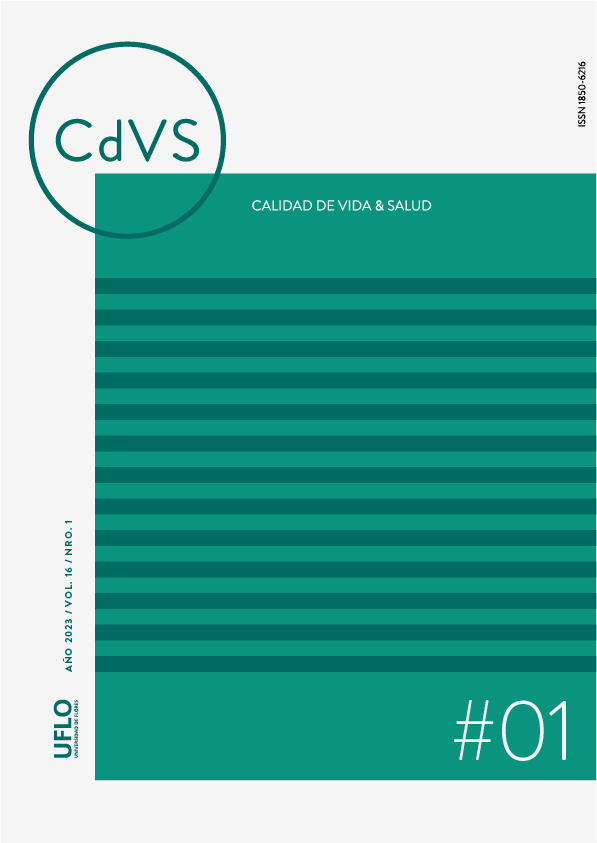Systematic review on quality of life in disabled athletes
wheelchair users
Keywords:
Quality of life, Parathletes, Wheelchair athletes, People with disabilities, ParalympiansAbstract
The purpose of this article is to carry out a systematic review of the quality of life in disabled athletes with physical disabilities who use wheelchairs, identifying those in which an analysis by domain stands out. The methodological approach was oriented under the qualitative paradigm, as a research method resulting from a documentary review in different databases through the tracking, organization, systematization and analysis of electronic documents between the years 2010-2020. These investigations reveal how different quality of life questionnaires are approached by domains, evaluating from the perception of the athlete in a wheelchair before and after training, recognizing their social, physical, and psychological capabilities and skills for comprehensive development, achieving have a better performance such as the use of the chair, it is found the evaluation of the perception of sleep that athletes are not generally affected, it is understood that sport brings as benefits an aerobic gain improves both physical condition and self-esteem thus achieving a better sports performance.
References
Águila Soto, C. Del deporte a la sociedad: sobre valores y desarrollo del ser humano. Almer Juega Limpio. https://www.dipalme.org/Servicios/Informacion/Informacion.nsf/1C9C7FA4EB0BD193C1257E54002B5648/$file/CornelioAguila.pdf
Amaral, M. P. D., Pinto, F. T., & De Medeiros, C. A. (2015). Las habilidades sociales y el comportamiento infractor en la adolescencia. Subjetividad y Procesos Cognitivos, 19(2), 17-38.
Bacelar Pousa, S. (2014). Deporte y calidad de vida en personas con discapacidad física. https://ruc.udc.es/dspace/handle/2183/12508
Bueno Burnham, N. (2020). Estudio comparativo de la calidad de vida en deportistas de alto rendimiento del Comité Paralímpico Ecuatoriano a través de la escala WHOQOL-BREF en el período Octubre 2019 - Febrero 2020. Trabajo de titulación previo a la obtención del Título de Licenciado en Terapia Física. Carrera de Terapia Física. Quito: UCE. 116 p. http://www.dspace.uce.edu.ec/handle/25000/21114
Ciampolini, V., Columna, L., Lapolli, B., Iha, T., Grosso, E. C., Silva, D. A. S., & Galatti, L. R. (2017). Quality of life of Brazilian wheelchair tennis athletes across competitive and elite levels. Mot Rev Educ Física, 23(2). https://doi.org/10.1590/s1980-6574201700020014
Ciampolini, V., Pinto, M. A. B., De Sousa, G. R., Silva, D. A. S., & Galatti, L. R. (2018). Do athletes with physical disabilities perceive their quality of life similarly when involved in different Paralympic Sports? Motriz: rev. educ. fis., 24(4). https://doi.org/10.1590/s1980-6574201800040004
Crosara de Resende, M., & Liberalesso Neri, A. (2005). Atitudes de adultos com deficiência física frente ao idoso, à velhice pessoal e a pessoas com deficiência física. Estudos de Psicologia, 22(2), 123-131. https://www.redalyc.org/articulo.oa?id=395336346002
Da Costa, L. C. A., Vissoci, J. R. N., Modesto, L. M., & Vieira, L. F. (2014). O sentido do esporte para atletas de basquete em cadeiras de rodas: processo de integração social e promoção de saúde. Revista Brasileira de Ciências do Esporte, 36(1), 123-140. https://doi.org/10.1590/s0101-32892014000100009
Da Cruz, A. O., Rodrigues, D. F., De Mello, M., De Moura Simim, M. A., Rosa, J. L. G., Winckler, C., & Da Silva, A. M. B. (2017). Percepção de qualidade de sono e de vida em atletas paralímpicos: comparação entre atletas com deficiência física e visual. Journal of Physical Education, 28(1). https://doi.org/10.4025/jphyseduc.v28i1.2835
DANE-DCD-CNPV (2019). Resultados censo nacional de población y vivienda. https://www.dane.gov.co/files/censo2018/informacion-tecnica/cnpv-2018-presentacion-funcionamiento-humano.pdf
Delgado, R. M., Toscano, Ú. P., y Latorre, M. L. A. (2016). Influencia de la práctica del Deporte Adaptado sobre la calidad de vida: un estudio cualitativo. EmásF: revista digital de educación física, (43), 53-68.
Esteves, A. M., Silva, A., Barreto, A. T., Cavagnolli, D. A., Ortega, L. S. A., Parsons, A. F., Tubiba, E. R., Barreto, M., De Oliveira Filho, W., Tufik, S., & De Mello, M. T. (2015). Avaliação da qualidade de vida e do sono de atletas paralímpicos brasileiros. Revista Brasileira De Medicina Do Esporte, 21(1), 53-56. https://doi.org/10.1590/1517-86922015210101980
Feter, N., Calonego, C., Cavanhi, A. C., & Del Vecchio, F. B. (2018b). Wheelchair basketball: fitness and quality of life. European Journal of Adapted Physical Activity, 11(1), 5. https://doi.org/10.5507/euj.2018.001
Fleck, Marcelo & Louzada, Sérgio & Xavier, Marta & Chachamovich, Eduardo & Vieira, Guilherme & dos Santos Tascone, Lyssandra & Pinzon, Vanessa. (2000). Application of the Portuguese version of the abbreviated instrument of quality life WHOQOL-BREF. Revista de saúde pública. 34. 178-83. https://doi.org/10.1590/S0034-89102000000200012
Galván Bonilla, M. A. (2014). ¿Qué es calidad de vida?. Logos Boletín Científico De La Escuela Preparatoria No. 2, 1(2). https://repository.uaeh.edu.mx/revistas/index.php/prepa2/article/view/1120
Lemus, N., Parrado, R., & Quintana, G. (2014). Calidad de vida en el sistema de salud. Revista Colombiana de Reumatología, 21(1), 1-3. http://www.scielo.org.co/scielo.php?script=sci_arttext&pid=S0121-81232014000100001&lng=en&tlng=es
López, E., Rocha, D., & Castillo, L. A. (2012). Relación entre cohesión y liderazgo en equipos deportivos del departamento de Boyacá - Colombia. Cuadernos de psicología del deporte, 12(1), 33-44. https://doi.org/10.4321/s1578-84232012000100004
Medola, F., Busto, R., Marçal, A., Junior, A., & Dourado, A. (2011). Sports on quality of life of individuals with spinal cord injury: A case series. Revista Brasileira de Medicina do Esporte. 17. 254-256. http://dx.doi.org/10.1590/S1517-86922011000400008
Montoya, N. P. M. (2005). ¿Qué es el estado del arte? Ciencia y Tecnología para la Salud Visual y Ocular, 5, 73. https://doi.org/10.19052/sv.1666
Oliva Concepción, B., Gómez Cardoso Á. L. La atención al deporte para discapacitados en Cuba: el deporte adaptado en el caso de limitaciones físico-motoras. https://www.efdeportes.com/efd166/deporte-para-discapacitados-en-cuba.htm
Ozmen, T., Yüktaşir, B., Yıldırım, N. Ü., Yalcin, B., & Willems, M. E. T. (2014). Explosive strength training improves speed and agility in wheelchair basketball athletes. Revista Brasileira De Medicina Do Esporte, 20(2), 97-100. https://doi.org/10.1590/1517-86922014200201568
Salas, C., y Garzón, M. (2013). La noción de calidad de vida y su medición (The concept of quality of life and measurement)(A noção de qualidade de vida e sua medição). CES Salud Pública, 4(1), 36–46. https://revistas.ces.edu.co/index.php/ces_salud_publica/article/view/2751
Samanes Prat J. J. A. (1998). Deportes adaptados. Arch Med del Deport., 15(66), 323–34. http://femede.es/documentos/Deporte_adaptado_323_66.pdf
Sampieri, R. H., Collado, C., y Lucio, P. (2010). Metodología de la investigación. En McGraw-Hill Interamericana eBooks (p. 613). http://148.202.167.116:8080/jspui/handle/123456789/2707
Santillán, P. S. (2015). TIC y discapacidad en América Latina. Hachetetepé. https://doi.org/10.25267/hachetetepe.2015.v1.i10.7
Silva, M. & Oliveira, R. & Conceicao, M. (2005). Effects of swimming on the functional independence of patients with spinal cord injury. Revista Brasileira de Medicina do Esporte. 11. 251-256.
Tejero, J., Vaíllo, R. R., & Rivas, D. A. (2012). La actividad física adaptada para personas con discapacidad en España: perspectivas científicas y de aplicación actual. (Adapted Physical activity for people with Disability in Spain: scientific perspectives and current issuess). Cultura, Ciencia y Deporte, 7(21), 213-224. https://doi.org/10.12800/ccd.v7i21.86
Vancini, R. L., Gomes, A. S., De Paula-Oliveira, H., De Lira, C. A. B., Rufo-Tavares, W., Andrade, M. S., Sarro, K. J., Sampaio, M. M., Viana, R. L., Nikolaidis, P. T., Rosemann, T., & Knechtle, B. (2019). Quality of life, depression, anxiety symptoms and mood state of wheelchair athletes and non-athletes: a preliminary study. Frontiers in Psychology, 10. https://doi.org/10.3389/fpsyg.2019.01848
Verdugo, M. A., Canal, R., Fernández, S., Bermejo, L., Alonso, S., Tamarit, J., et al. (2015). Modelo de calidad de vida aplicado a la atención residencial de personas con necesidades complejas de apoyo. La toma de decisiones para el desarrollo de su proyecto de vida, 1–128. https://infoautismo.usal.es/wp-content/uploads/2015/10/04._Libro.pdf
Zelenka, T., Kudláček, M., & Wittmannová, J. (2017). Quality of life of wheelchair rugby players. European Journal of Adapted Physical Activity, 10(2), 31-35. https://doi.org/10.5507/euj.2017.008
Published
How to Cite
Issue
Section
Copyright (c) 2023 Ricardo Rengifo Cruz, Lina Marcela Cespedes , Katherin Rosas Arroyo, Olga Lucia Hincapié

This work is licensed under a Creative Commons Attribution-NonCommercial-ShareAlike 4.0 International License.
The authors who publish in this journal accept the following conditions:
1. The authors retain the copyright and assign to the journal the right to first publication, with the work registered under the Creative Commons Attribution license, which allows third parties to use what has been published as long as they mention the authorship of the work and the first publication in this journal.
2. Authors may make other independent and additional contractual agreements for non-exclusive distribution of the version of the article published in this journal (e.g., inclusion in an institutional repository or publication in a book) provided that they clearly indicate that the work was first published in this journal.
3. Authors are permitted and encouraged to publish their work on the Internet (e.g., on institutional or personal pages) before and during the review and publication process, as this may lead to productive exchanges and greater and faster dissemination of published work (see The Effect of Open Access).









